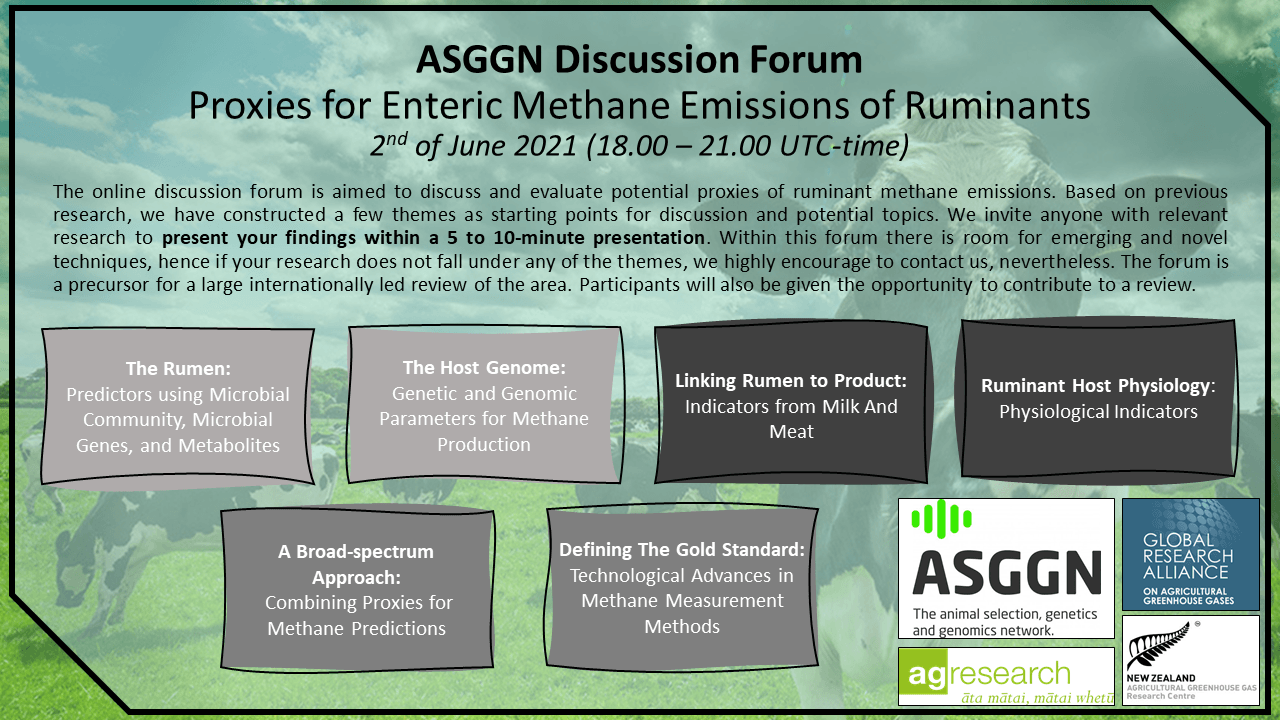Proxy Discussion Forum
ASGGN DISCUSSION FORUM: (UPDATE 23/06/2021)
Thank you to everyone who has attended or participated in the ASGGN Discussion Forum. We hope you enjoyed it as much as we did.
Did you miss the event or want to watch it again? Do not worry, as we have uploaded the discussion forum here.
The online chat was just as lively as the discussion, hence we transcribed the conversation within the chat.
Document: :
ASGGN DISCUSSION FORUM: PROXIES FOR ENTERIC METHANE EMISSIONS OF RUMINANTS
A large contributor to global methane emissions are ruminant animals, in particular cattle. Selecting and breeding for low methane emitting ruminants could be part of the solution for global governments in reaching their climate goals. Yet, large-scale direct measurement of enteric methane emissions, with the most accurate method being respiration chambers, is currently expensive. Indicators or indirect traits of the ruminant’s methane production, so-called proxies, may offer a cheap and easily accessible alternative to direct methane measurement. Although a variety of proxies have been identified and examined, the perfect proxy to predict CH4 at low cost is yet to be found.
On the 2nd of June 2021 (18.00 – 21.00 UTC-time) an informal online discussion forum will be held, aimed to discuss and evaluate potential proxies of ruminant methane emissions. Based on previous research, we have constructed a few themes as starting points for discussion and potential topics.
We invite anyone with relevant research to present or discuss their findings within a 5 to 10-minute presentation. Please let us know before the 28th of May if you would like to present.
Within this forum there is room for emerging and novel techniques. Hence if your research does not fall under any of the themes, we highly encourage you to contact us and to join the discussion. The discussion forum is a precursor for a large internationally led review of the area. Participants will also be given the opportunity to contribute to a review.
The online discussion forum will be held over Microsoft Teams. Attendees will receive the link to the meeting in advance of the event, which can be opened through either the desktop app or supported browsers (Microsoft Edge, Google Chrome, Firefox, and Safari). To accommodate for the differences in time-zones, pre-recorded presentations in PowerPoint are preferred.
REGISTRATION IS CLOSED. Any questions? Please contact ASGGN@agresearch.co.nz
THEMES
The following themes are based on the extensive review by Negussie et al. (2017), with the addition of recently published literature. The proxies mentioned are just mere suggestions and any novel proxies not yet mentioned are highly welcome.
THEMES FOR POTENTIAL PROXIES
- The Rumen: Predictors using Microbial Community, Microbial Genes, and Metabolites
The rumen microbiome is fundamentally tied to methane production and therefore provides a wide range of potential proxies. This ranges from analysing the whole microbial community or rumen metagenome to focusing on specific microbes, metabolites, or genes associated with methane production.
- The Host Genome: Genetic and Genomic Parameters for Methane Production
With methane production being a moderately heritable trait, the use of genomic relationships or presence of specific genomic variants is a logical next step. These proxies not only provide information on which animals are low or high emitters but could be used for breeding low-emitting flocks, providing a long-term and economically sustainable solution for the agricultural industry.
- Linking Rumen to Product: Indicators from Milk and Meat
The methanogenesis of ruminants is partially reflected in its product. Milk and meat products could be analyzed through their composition and production traits. Recent research on milk have been able to predict methane phenotypes with the help of milk fatty acids profiles, as well as directly from the Mid-Infrared spectra of the milk. In particular, infrared spectroscopy has proven to be a valuable tool for phenotyping milk samples.
- Ruminant Host Physiology: Physiological Indicators
Physiological indicators of the ruminant can provide valuable information about its methane production, either as a singular or complementary proxy to other proxies. In terms of the overall animal, potential proxies could be body weight, conformation, and animal type, while at the rumen level, rumen volume and pH have shown to be indicators of methane production.
GENERAL TALKING POINTS
- A Broad-spectrum Approach: Combining Proxies for Methane Predictions
Methanogenesis of cattle is a complex process, with a variety of independent sources influencing variation in methane emissions. Combining proxies may cover a wider spectrum of these sources and overcome shortcomings in using proxies individually.
- Defining the Gold Standard: Technological Advances in Methane Measurement Methods
Although methane proxies are the best tool for large scale methane estimation of cattle accurate direct methane measurements are essential to evaluate these proxies. Benchmarking proxies against direct methane measurements provides a valid comparison of the accuracies of these proxies. Direct methane measurements methods vary in terms of cost, labour, repeatability, and most importantly, accuracy.

Contact Us
We will get back to you as soon as possible
Please try again later
